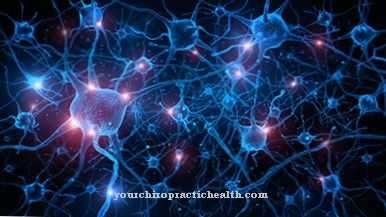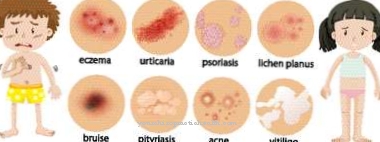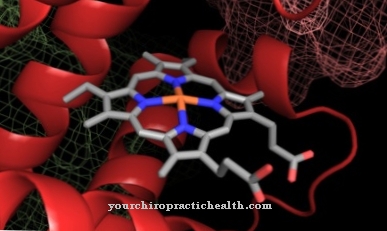Brain atrophy refers to the ongoing loss of brain mass and neuronal connections in the brain. The causes can be a number of diseases. Those affected suffer from limitations in their mental and / or motor skills.
What is brain atrophy?

© SOPONE - stock.adobe.com
Brain atrophy or Brain wasting is a common byproduct of several neural disorders. Both the entire brain and individual parts of the brain can be affected by the decline in cells. The effects of the disorder strongly depend on which parts of the brain are affected.
Common symptoms are dementia, convulsions, loss of motor skills, difficulty speaking, reading, or general understanding. Dementia is characterized by memory loss and the inability to complete everyday tasks. The intensity can vary and increase as the disease progresses.
causes
The causes of Brain atrophy are various diseases, accidents or infections of the brain. Atrophy can set in after a stroke or severe brain trauma, triggered for example by a traffic accident.
A variety of genetic or developmental disorders can also cause brain atrophy. These include Alzheimer's disease, cerebral palsy (group of neuronal diseases that affect movement, balance and posture), dementia, chorea disease (genetically caused degenerative brain disease), leukodystrophy (genetic metabolic disease), multiple sclerosis, Pik's disease (neurodegenerative aging disease).
AIDS, meningitis, and syphilis can also cause brain atrophy. Risk factors include brain injury, old age, a family history of neural or autoimmune diseases, and head injuries.
Symptoms, ailments & signs
Brain atrophy can cause various symptoms and ailments depending on its cause. In general, atrophy results in seizures, hallucinations, and other disturbances of consciousness. Speech disorders, so-called aphasia, can also occur. These aphasias increase in intensity as the disease progresses and are expressed, for example, by swallowing words or a very slurred pronunciation.
Sensory aphasia becomes noticeable when the person concerned is no longer able to recognize objects and people. Most patients also have epileptic seizures. The affected person then repeatedly experiences severe convulsions, loses consciousness or makes unusual movements.
Persistent disorientation is also typical. One possible long-term consequence of brain atrophy is dementia. Patients lose the ability to learn and understand over time, and complex actions like organizing and planning are no longer possible. As cerebral atrophy progresses, cognitive performance continues to decline.
This often results in psychological complaints such as mood swings or depression. Also delusional thoughts and permanent changes in personality are part of the clinical picture of brain atrophy. In severe cases, the disease is fatal.
Diagnosis & course
It is not uncommon for those affected to stand out due to a change in their behavior or personality, are disoriented and have trouble thinking. Dizziness or blurred vision can also be the first symptoms.
Intervention should be made at the latest when there is a partial loss of consciousness or the endangerment of one's own well-being and others. When the listed symptoms appear, especially in connection with the diseases mentioned, there are a number of diagnostic procedures with the Brain atrophy can be determined.
These include computed tomography, in which a large number of detailed photographs of the brain are made from different angles; Magnetic resonance tomography, also known as magnetic resonance tomography, here produces sectional images of the tissue for analysis; The similarly proceeding positron emission tomography or single photon emission computed tomography.
Complications
The brain atrophy leads to a drastic reduction in brain mass. In most cases, this reduction leads to severe limitations in the patient's physical and mental abilities. This reduction is still irreversible and cannot be reversed, so that the person affected usually has to suffer from the symptoms of brain atrophy for the rest of his life.
This leads to paralysis in various parts of the body and failure symptoms. Speech disorders or memory disorders also occur and clear thinking and acting is no longer possible for the patient in most cases. The number of brain cells drops drastically, resulting in a decrease in intelligence and thus a retardation. It is not uncommon for psychological complaints and personality disorders to occur.
Most patients also have mood swings. The brain atrophy also leads to dizziness and blurred vision, with a visual aid not bringing about any improvement. Treatment of brain atrophy is not possible. The course can be restricted, but it is not possible to reverse the symptoms. In most cases the patient is then dependent on the help of other people in everyday life.
When should you go to the doctor?
People suffering from seizures should consult a doctor to clarify the cause. If hallucinations, confusion or false senses occur, a doctor should be consulted. A medical examination is necessary as soon as behavioral problems and changes in personality appear. If the person has a depressed mood or is aggressive, the observations should be discussed with a doctor. If you are very euphoric or have a weeping mood for no reason, there is cause for concern.
A doctor's visit is necessary to determine the cause. Anomalies in memory activity, memory gaps, memory impairment or obviously incorrect memories should be examined more closely. In the event of disorientation or an inability to cope with everyday life, the person concerned needs medical help. If performance is reduced or the social skills learned cannot be used, a doctor should be consulted.
A loss of language skills, apathetic behavior, or a feeling of alienation should seek advice from a doctor. Since cerebral atrophy can develop into a fatal course in severe cases, a doctor's visit should be initiated as soon as possible if the person concerned behaves abnormally. An incomprehensible withdrawal behavior or a sudden exuberant behavior indicate a disease that will progress without treatment. Consult a doctor in the event of unexplained motor problems, unsteady gait or seizures.
Doctors & therapists in your area
Treatment & Therapy

New studies have shown initial success in the high-dose clinical administration of vitamin B complexes. Physiotherapy improves the physical ability to cope with daily tasks. Psychological counseling can also be considered.
The basic therapy to stop the progression of the brain atrophy is to maintain a healthy lifestyle. This includes a healthy and balanced diet with rich vegetables and fruits, regular physical training and mental activities such as reading, chess or memory sports. Proper nutrition is very important here. Surveys have shown that people who eat fish at least once a week have a 60 percent reduced risk of developing Alzheimer's. The prophylactic omega 3 fatty acids are contained in fish.
Folic acid, which is contained in spinach, many types of cabbage, as well as tomatoes, asparagus, whole grain rye, yeast, wheat germ, liver and egg yolk, is a health factor. Lecithin, found in corn, soy, seeds and legumes, is said to have positive effects on memory performance. Alternative therapies can also help those affected to cope with their illness and improve their physical and mental well-being. Methods such as acupuncture, massage or yoga should be mentioned here.
You can find your medication here
➔ Medicines against memory disorders and forgetfulnessOutlook & forecast
The prognosis for cerebral atrophy is unfavorable, since this disorder is irreparable damage to the brain tissue. Despite numerous therapeutic approaches, malfunctions can no longer be completely corrected. At best, the further course of the disease at hand can be positively influenced. This depends on the underlying disease and the age of the patient. In addition, the detailed prospect of the further course must be assessed individually after the overall diagnosis is available.
In severe cases, the patient suffers from an illness in which the state of health deteriorates immensely within a short period of time. In addition, the patient is at risk of premature death due to the damage and the consequential damage. In the case of a comparatively less serious underlying disease such as multiple sclerosis, the progress of the disease can be slowed down thanks to modern medical options with extensive, early and good treatment. There are also various options for treating the other symptoms of the disease quickly and effectively. This has a positive influence on the general state of health, as it significantly improves the patient's quality of life overall.
In the case of cerebral atrophy, doctors try to use the right treatment methods to extend the life of the person affected and at the same time to stabilize their well-being as best as possible. A cure or recovery is not possible according to the current scientific status.
prevention
Against a genetic disposition to diseases that are part of Brain atrophy occur, there is no all-round solution. However, a healthy lifestyle prevents diseases such as Alzheimer's disease, where treatment and prophylaxis overlap. Regular exercise, an active everyday life and mental fitness are the be-all and end-all. High blood pressure should be treated early, as should being overweight. These factors can become the breeding ground for cerebral atrophy in old age, as they lead to promoting diseases.
Aftercare
In the case of cerebral atrophy, the person concerned usually has very few or even no measures and direct follow-up options available. Therefore, the early detection and treatment of this disease is in the foreground so that there are no further compilations and complaints and so that the complaints do not continue to worsen. Self-healing cannot occur with brain atrophy.
The treatment of brain atrophy is mostly done by taking medication. In any case, it is important to ensure the correct dosage with regular intake. All instructions of the doctor must also be observed. If anything is unclear or if you have any questions, a doctor should always be consulted first. Often the care and support of one's own family or friends also has a positive effect on the course of this disease.
Psychological counseling can also be useful. In many cases, a change in diet is necessary, and a doctor can also create a nutrition plan. In general, a healthy lifestyle with a healthy diet always has a positive effect on the further course of the disease. The life expectancy of the person affected may also be reduced by the brain atrophy.
You can do that yourself
Depending on the causal disease, medical therapy for brain atrophy can be supported by various self-help measures.
If the symptoms are caused by a stroke, treatment focuses on restoring neurological and mental abilities. This can be supported, for example, by movement exercises, thinking games and generally by an active lifestyle that is physically and mentally demanding. Also as a result of traumatic brain injuries, those affected have to slowly find their way back to life through exercises and the support of relatives.
If the brain atrophy occurs as a result of multiple sclerosis or epilepsy, these diseases must be treated first. The brain atrophy itself can at least be slowed down by treating the underlying disease. However, drug therapy is always required. If the brain atrophy is due to alcohol or drug abuse, withdrawal must be carried out immediately. In addition, physiotherapeutic and psychotherapeutic measures must be taken.
Damage that has already occurred due to brain atrophy cannot be completely repaired, but by making appropriate changes in lifestyle, those affected can live a relatively symptom-free life. Close monitoring by the doctor is always necessary when brain atrophy is diagnosed.





.jpg)







.jpg)

.jpg)
.jpg)











.jpg)